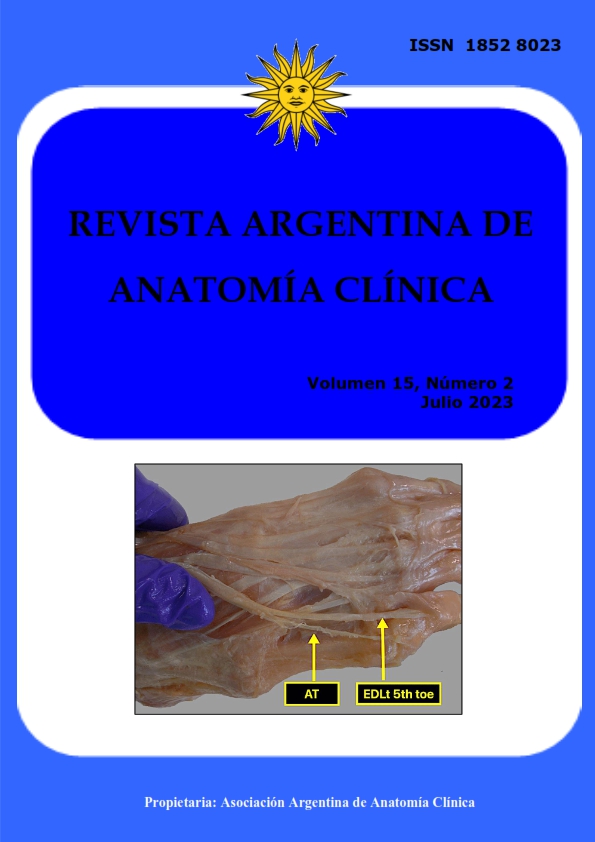RELACIÓN ENTRE LONGITUD FEMORAL Y NERVIO GLÚTEO SUPERIOR EN ABORDAJES POSTERIOR A LA ARTICULACIÓN COXOFEMORAL
DOI:
https://doi.org/10.31051/1852.8023.v15.n2.40603Palabras clave:
Nervio glúteo superior, Articulación coxofemoral, Zona segura, Longitud femoralResumen
Objetivos: Evaluar la longitud femoral como predictor en la localización del nervio glúteo superior en el abordaje transglúteo a la articulación coxofemoral. Materiales y métodos: Se realizó un estudio de disección cadavérica en 15 regiones glúteas correspondientes a especímenes cadavéricos adultos formolizados al 10%. Por abordaje transglúteo se identificó el NGS y sus ramos terminales superior e inferior. Se midió la distancia entre la punta del trocánter mayor (TM) y el ramo terminal inferior del NGS, así como también la longitud femoral. Se realizó análisis de varianza (ANOVA) para determinar diferencias significativas entre la distancia del TM–NGS según sexo y regresión múltiple para establecer si la longitud femoral y el sexo son predictores significativos de la distancia TM–NGS. Resultados: La distancia TM–NGS promedio fue de 49,05 mm (rango 39,2 a 59,7 mm) y la longitud femoral media para ambos sexos fue de 41,92 cm. El análisis de varianza no mostró diferencias significativas en la distancia TM–NGS según sexo (p=0,82) y el análisis de regresión múltiple no encontró relación significativa entre longitud femoral y la distancia TM–NGS (p=0,93). Conclusiones: Los resultados del presente estudio no establecieron correlación significativa entre longitud femoral y la distancia entre el nervio glúteo superior y el trocánter mayor en el abordaje transglúteo a la articulación coxofemoral.
Referencias
Apaydin N, Kendir S, Loukas M, Tubbs RS, Bozkurt M. 2013. Surgical anatomy of the superior gluteal nerve and landmarks for its localization during minimally invasive approaches to the hip. Clin Anat 26: 614-20.
Barrack RL, Butler RA. 2003. Avoidance and management of neurovascular injuries in total hip arthroplasty. Instr Course Lect 52: 267-74.
Bhatia A, Hoydonckx Y, Peng P, Cohen SP. 2018. Radiofrequency Procedures to Relieve Chronic Hip Pain: An Evidence-Based Narrative Review. Reg Anesth Pain Med 43: 72-83.
Dujardin F, Mure JP, Roussignol X, Lukasiewitch M, Toupin JM, Beccari R, Duparc F, Thomine JM. 2007. Approach of the hip joint by anterior hemimyotomy of the gluteus medius. Approach of Thomine. Interactive Surgery 2: 144-48.
Eksioglu F, Uslu M, Gudemez E, Atik OS, Tekdemir I. 2003. Reliability of the safe area for the superior gluteal nerve. Clin Orthop Relat Res 412: 111-16.
Gore DR, Murray MP, Sepic SB, Gardner GM. 1982. Anterolateral compared to posterior approach in total hip arthroplasty: differences in component positioning, hip strength, and hip motion. Clin Orthop Relat Res 165: 180-87.
Ince A, Kemper M, Waschke J, Hendrich C. 2007. Minimally invasive anterolateral approach to the hip: risk to the superior gluteal nerve. Acta Orthop 78: 86-89.
Jacobs LG, Buxton RA. 1989. The course of the superior gluteal nerve in the lateral approach to the hip. J Bone Joint Surg Am 71: 1239-43.
Kawasaki M, Hasegawa Y, Okura T, Ochiai S, Fujibayashi T. 2017. Muscle Damage After Total Hip Arthroplasty Through the Direct Anterior Approach for Developmental Dysplasia of the Hip. J Arthroplasty 32: 2466-73.
Khan T, Knowles D. 2007. Damage to the superior gluteal nerve during the direct lateral approach to the hip: a cadaveric study. J Arthroplasty 22: 1198-1200.
Lohana P, Woodnutt DJ, Boyce DE. 2010. Sciatic nerve palsy--a complication of posterior approach using enhanced soft tissue repair for total hip arthroplasty. J Plast Reconstr Aesthet Surg 63: e400-e401.
Lüdemann M, Kreutner J, Haddad D, Kenn W, Rudert M, Nöth U. 2012. MRI-based measurement of muscle damage after minimally invasive hip arthroplasty. Orthopade 41: 346-53.
Mayr E, Nogler M, Benedetti MG, Kessler O, Reinthaler A, Krismer M, Leardini A. 2009. A prospective randomized assessment of earlier functional recovery in THA patients treated by minimally invasive direct anterior approach: a gait analysis study. Clin Biomech 24: 812-18.
Nazarian S, Tisserand P, Brunet C, Müller ME. 1987. Anatomic basis of the transgluteal approach to the hip. Surg Radiol Anat 9: 27-35.
Miguel Pérez M, Llusá M, Ortiz J-C, Lorente M, Lopez I, Lazaro A, Pérez A, Götzens V. 2004. Superior gluteal nerve: safe area in hip surgery. Surg Radiol Anat 26(3): 225-29.
Pellicci PM, Bostrom M, Poss R. 1998. Posterior approach to total hip replacement using enhanced posterior soft tissue repair. Clin Orthop Relat Res 355: 224-28.
Rodriguez J, Deshmukh A, Rathod P, Greiz M, Deshmane P, Hepinstall M, Ranawat A. 2014. Does the direct anterior approach in THA offer faster rehabilitation and comparable safety to the posterior approach?. Clin Orthop Relat Res 472: 455-63.
Shaw JA. 1991. Experience with a modified posterior approach to the hip joint. A technical note. J Arthroplasty 6: 11-18.
Descargas
Publicado
Número
Sección
Licencia
Derechos de autor 2023 Valentín Thomas, Guillermina Pérez Gómez, Brisa de L. Perez Muquini, Juan I. Rossone, Carlos M. Quinteros

Esta obra está bajo una licencia internacional Creative Commons Atribución-NoComercial 4.0.
Los autores/as conservarán sus derechos de autor y garantizarán a la revista el derecho de primera publicación de su obra, el cuál estará simultáneamente sujeto a la Licencia de reconocimiento de Creative Commons que permite a terceros compartir la obra siempre que se indique su autor y su primera publicación en esta revista. Su utilización estará restringida a fines no comerciales.
Una vez aceptado el manuscrito para publicación, los autores deberán firmar la cesión de los derechos de impresión a la Asociación Argentina de Anatomía Clínica, a fin de poder editar, publicar y dar la mayor difusión al texto de la contribución.



